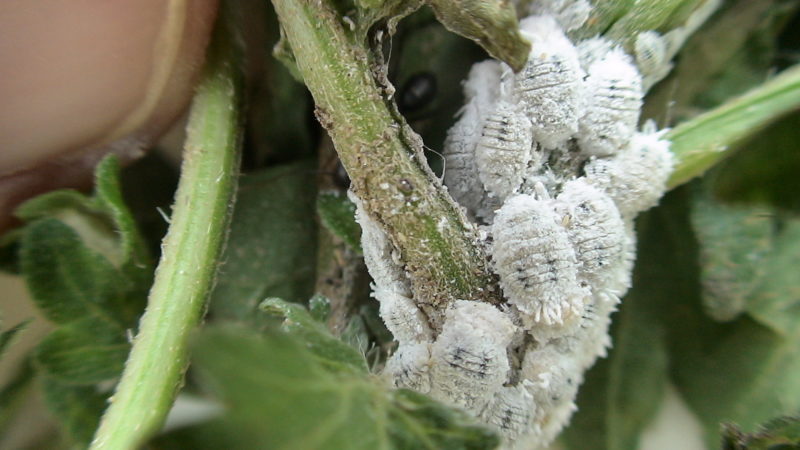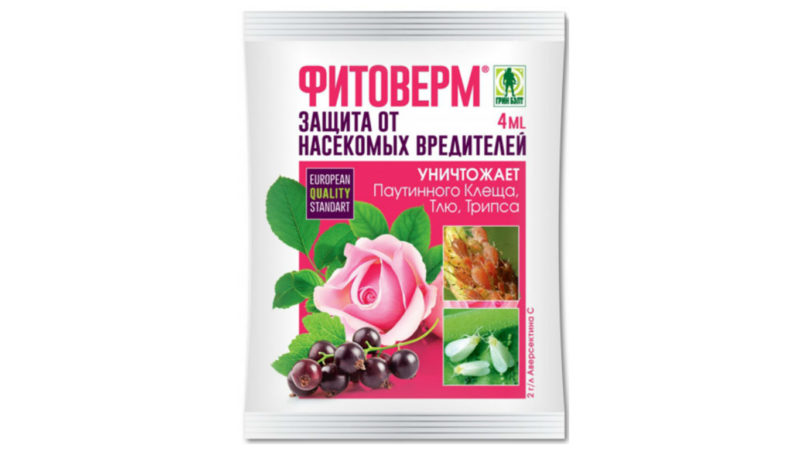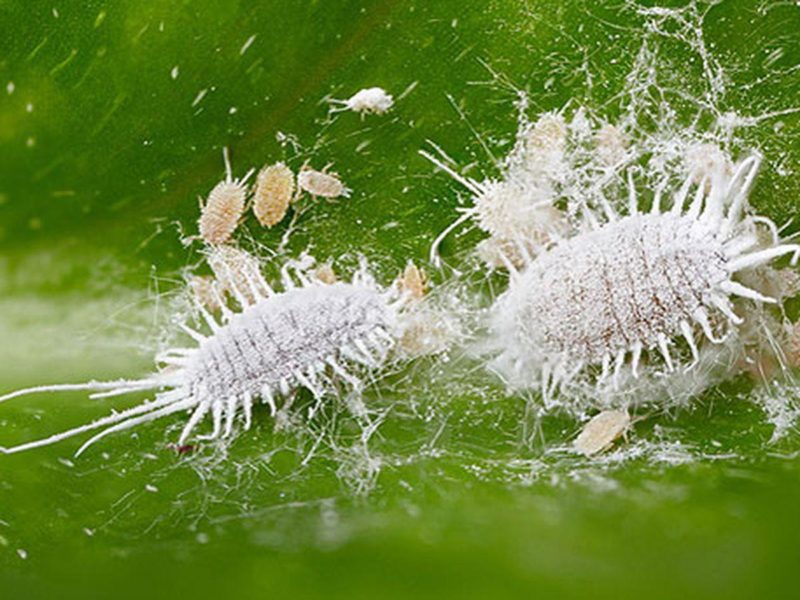Parasites are very mobile, their body is covered with snow-white powdery coating, pests can have wax plates on the edge. Body length from 0.5 mm to 12 mm. Males have wings, on the abdomen there are 2 tail threads or a whole bunch.
Female parasites leave up to 2000 eggs on the plant; they are placed in whitish secretions, similar to cotton balls. After the activity of the females, liquid remains, a soot fungus multiplies on the cultures. Insects can be 7 species.
Material Content:
External signs of damage to the plant by mealybug

Mealybugs, usually very easy to see, most of them can be below and in the axils of the foliage, on the petioles and stems. In these places, discharge resembling cotton wool is visible, they contain eggs. Therefore, plants that have been attacked by a mealybug are as if covered with cotton wool or fluff. Further, larvae hatch from the eggs, they crawl through the culture and suck the juice.
What plants are most often affected and what is dangerous?
Citrus crops attack citrus crops (grapefruit, citron, mandarin, orange, calamondin). In females, the body is up to 4 mm, it is light pink, covered with a whitish coating. Females after 15 days of their life lay eggs. They live 3 months. Males are beige in color, have transparent wings, live 2-4 days.
The grapeworm attacks the grapes. The female has a wide oval body, it is pinkish or yellowish, has a white coating, reminiscent of powder. Males come across rather rarely.
Parasites also attack: aglaonemes, adeniums, dracaena, succulents, amaryllis, orchids, azaleas, asparaguses, chlorophytums, dieffenbachia, hoya, violets, cacti, palm trees, fuchsias, camellias, gerberas, oleanders, philodendrons, calanthus, anthurium, anthurium, anthurium, anthurium, anthurium .
These crops are affected by a bristly mealybug. The female has a body of 3.5 mm, has an orangeish or pinkish tint, is covered with a coating. And there is a seaside worm. The female has a body up to 3-4 mm, it is pinkish-gray, with a snow-white coating. Males are smaller, they have wings. The larvae are tiny, yellowish in color, they move quickly, they have no plaque.
As a result of the appearance of the mealybug, the flowers stop growing; shoots are deformed; foliage, ovaries, fruits fall; branches dry up. During their activity, females secrete honey dew, and after that a sooty fungus appears on it.
How to deal with mealybug on indoor plants?
To kill a pest from biological preparations, lepidocide is used.
Effective Chemicals

You can get rid of the mealybug by spraying indoor crops: Thiophos, Actellik, Vertimek, Nurell-D, Fozalon, Fitoverm, Fosbetsis, karbofos, Tsvetofos, Intavir, Decis. After spraying, take a break a week and repeat spraying. The least dangerous for humans and animals is the drug Fitoverm. Pour 2 ml of Fitoverma into a glass of water, stir and spray the indoor culture. The treatment is repeated after a week. So that the insecticide sticks to parasites, you can pour a little liquid for washing dishes into the composition.

The solution of these chemicals absorb the roots of the culture and spread throughout the plant. As a result, parasites sucking juices poison and die.
Treatment with folk remedies
If there are few worms, then to fight parasites, moisten a soft brush or a cotton swab in soap and water. Gently wipe the plant with it, cleaning off the parasites and white excreta. After thoroughly rinse the plant in the shower, especially the lower part of the foliage.
Then spray with a solution of green soap, rubbing 10-15 g in 1 liter of water. Spray this 3 times at intervals of one week. Instead of soap, you can use tobacco infusion, garlic juice, onion juice or cyclamen broth. You can treat the plant with alcohol or tincture of calendula. Place the peels of mandarin or orange in the water, leave for 1-2 days, and then sprinkle the culture with infusion.
It is interesting:mealybug on an orchid
Grate 1 teaspoon of soap, pour hot water. Then add water so that the result is 1 liter, pour 1 more tbsp. spoon of alcohol or 2 tbsp. tablespoons of vodka. Cover the soil in a pot with something, and then wet the cotton wool in a solution of alcohol, collect all the pests, change the cotton wool from time to time. The next day, rinse the culture with warm water. And after 3-4 days, repeat the treatment.
Mash 25-70 g of garlic, pour 1 liter of boiling water, leave for 6 hours, and then wipe the indoor culture with a brush soaked in infusion. Do it in the evening. Next 2 days, cover the plant from sunlight.
Pour in 2 tbsp. tablespoons of olive oil in 1 liter of water. Wipe the entire plant with a dampened cotton.
Gather the horsetail grass, dry, chop, 4 teaspoons of grass pour in 0.5 l of boiling water. Leave on for 20 minutes. Strain the infusion, spray and water the crop with it.
Mealybug on an orchid: treatment

Orchids are mainly attacked by citrus and bristly mealy bugs. Females of the bristly mealy mealybug are reddish and covered with a whitish bloom. Long hairs are visible behind their bodies. The males are grayish, they have transparent wings.
Healthy well-groomed orchids secrete substances that repel a variety of insects, including mealybugs. Therefore, a mealybug on an orchid appears if the plant is sick.
Mealybug, how to fight on indoor plants?
If you saw parasites on the orchid, then isolate the plant from others.Tear off the diseased buds and discard them, wipe the leaves with cotton wool. Peel the sprouts and cut them by 1 cm. If you see pests in the middle, then remove them with tweezers. Remove the scales from the pseudobulb.
Then grate the dark laundry soap, pour it into the settled water and mix. Next, thoroughly wipe the leaves and stems of the orchid with the resulting foam. At the end, treat the culture with copper sulfate or another fungicide. Fungicides are required to not hit the ground.
Violet disease control methods
Mealybug on violets appears for such reasons:
- moving pests from newly acquired crops to old ones;
- use of pest infected land;
- excessive feeding with nitrogen;
- lack of moisture.
If you notice parasites, then remove the violet from the pot, shake off the substrate from the roots, treat it with an insecticide, and transplant it into a new soil.
Pour vases with boiling water or a bleach solution. Process all crops that are standing next to the windowsill. In addition, wipe the shelves and windowsills with bleach and alcohol. It is required to do all this by putting on disposable gloves, it is better to burn them then, and wash them with soap after hand. Sprinkle the plants with Actellic, pouring 2 ml into 1 liter of water. Then in a week do the treatment again.
You can water the land in a flowerpot with Aktara solution by adding 1.4 g to 2 liters of pure water. Then sprinkle the violet itself. Then wait 1 month and repeat again. Or use Phosphamide, it enters the culture in solution, and after that the insects sucking the juices etch and die. To work with pesticides put on a respirator.
Pest Prevention at Home
Inspect the indoor flower regularly. Mealybug is afraid of high humidity and loves dry soil.
Properly care for the plant, tear off yellowed and dried leaves. Rinse the plant constantly in the shower to flush dust off the leaves.












